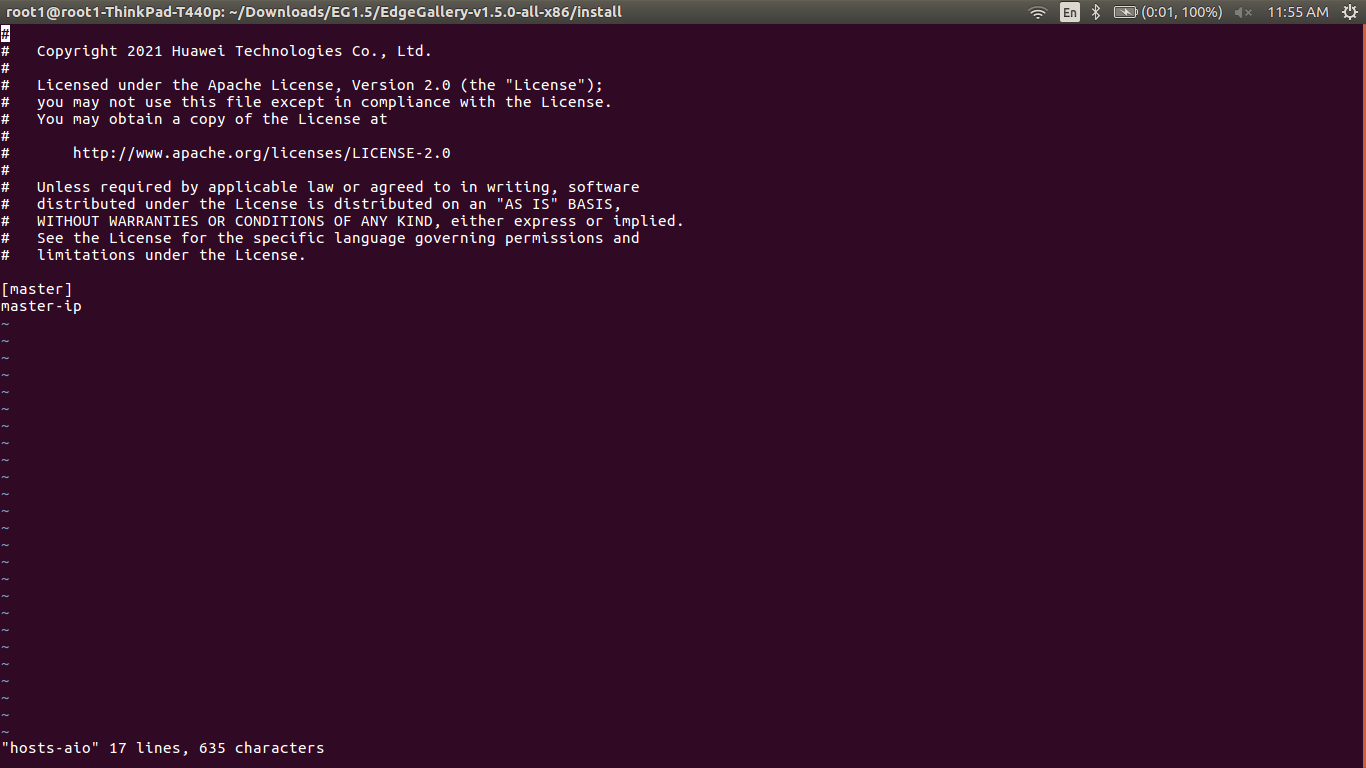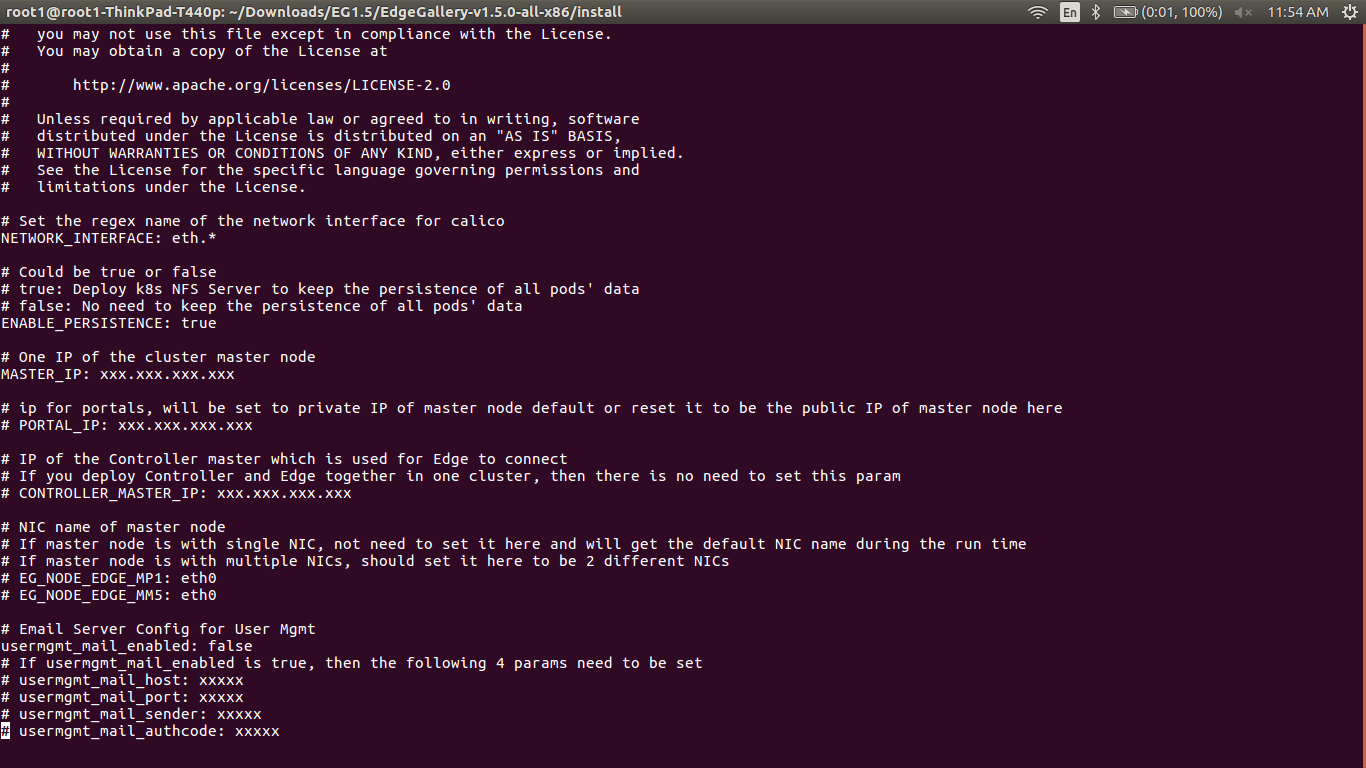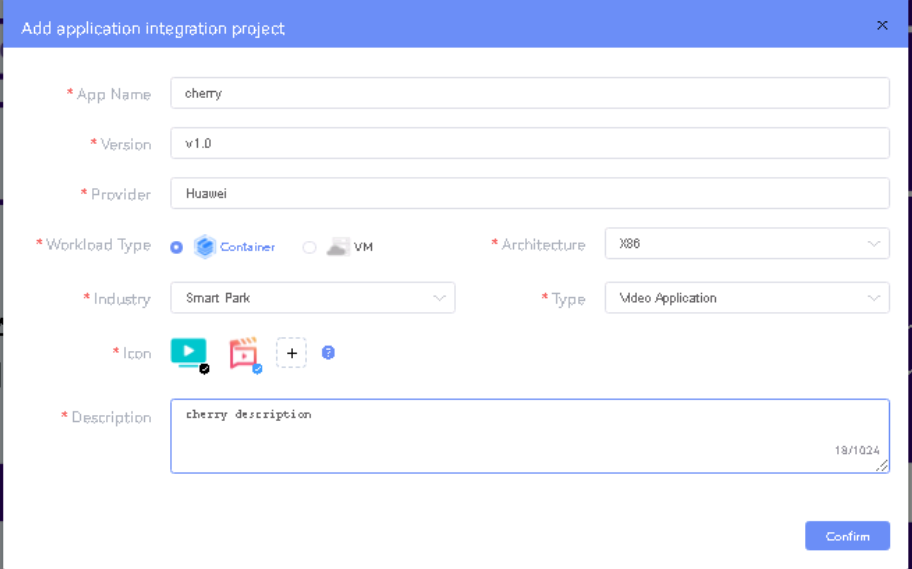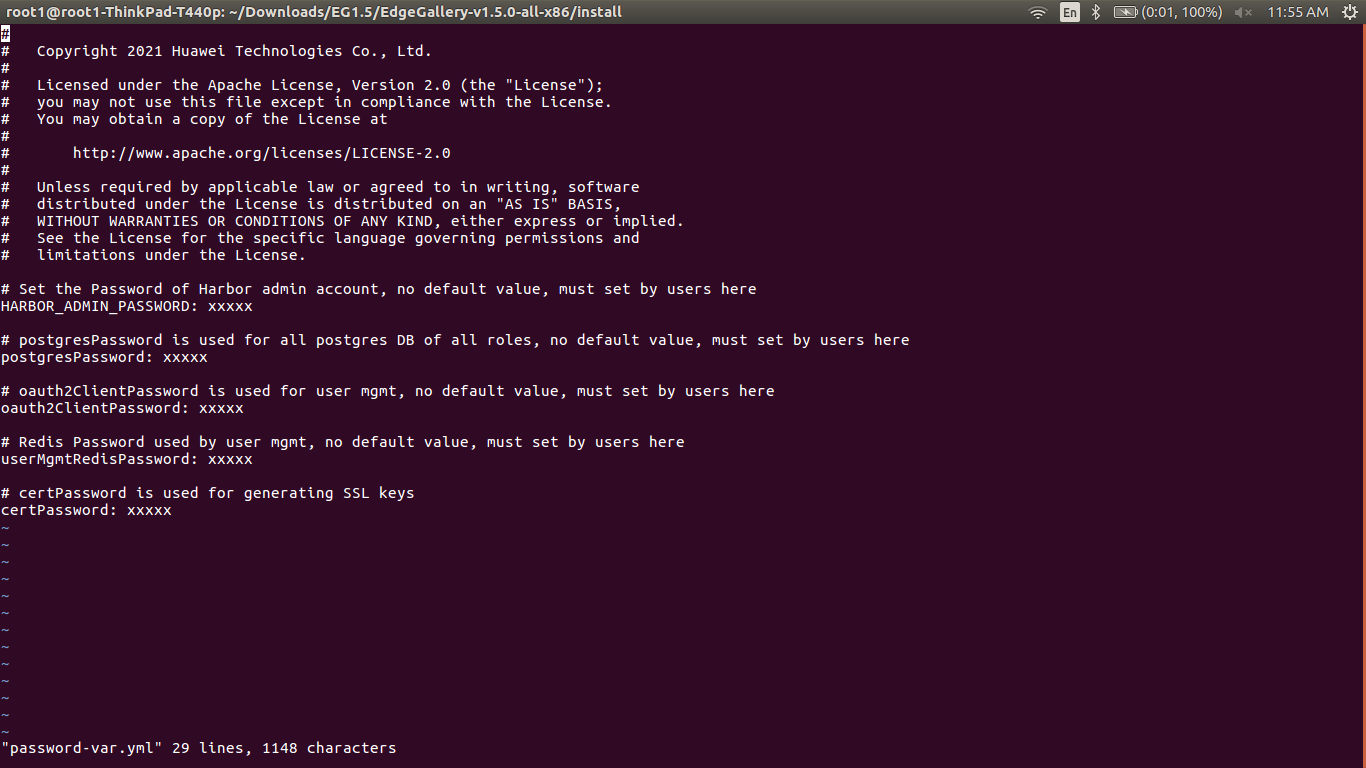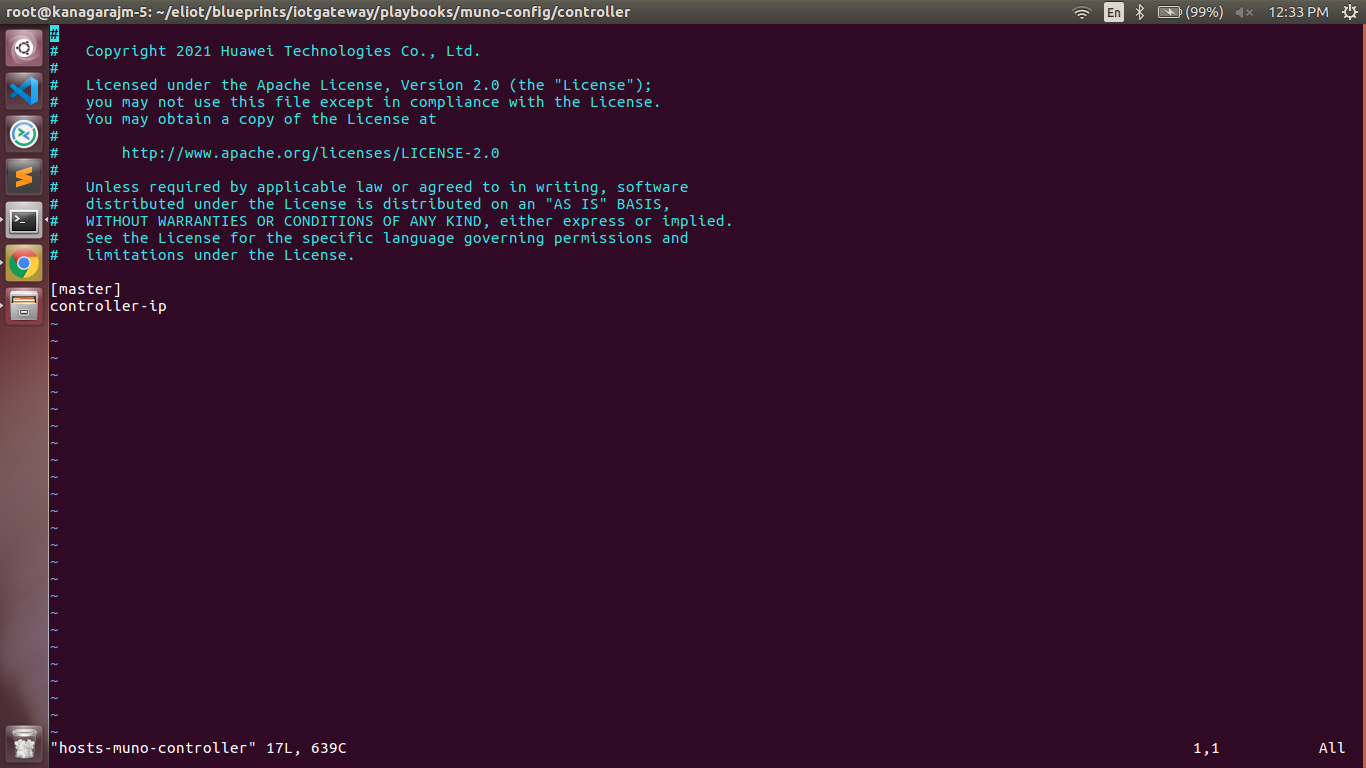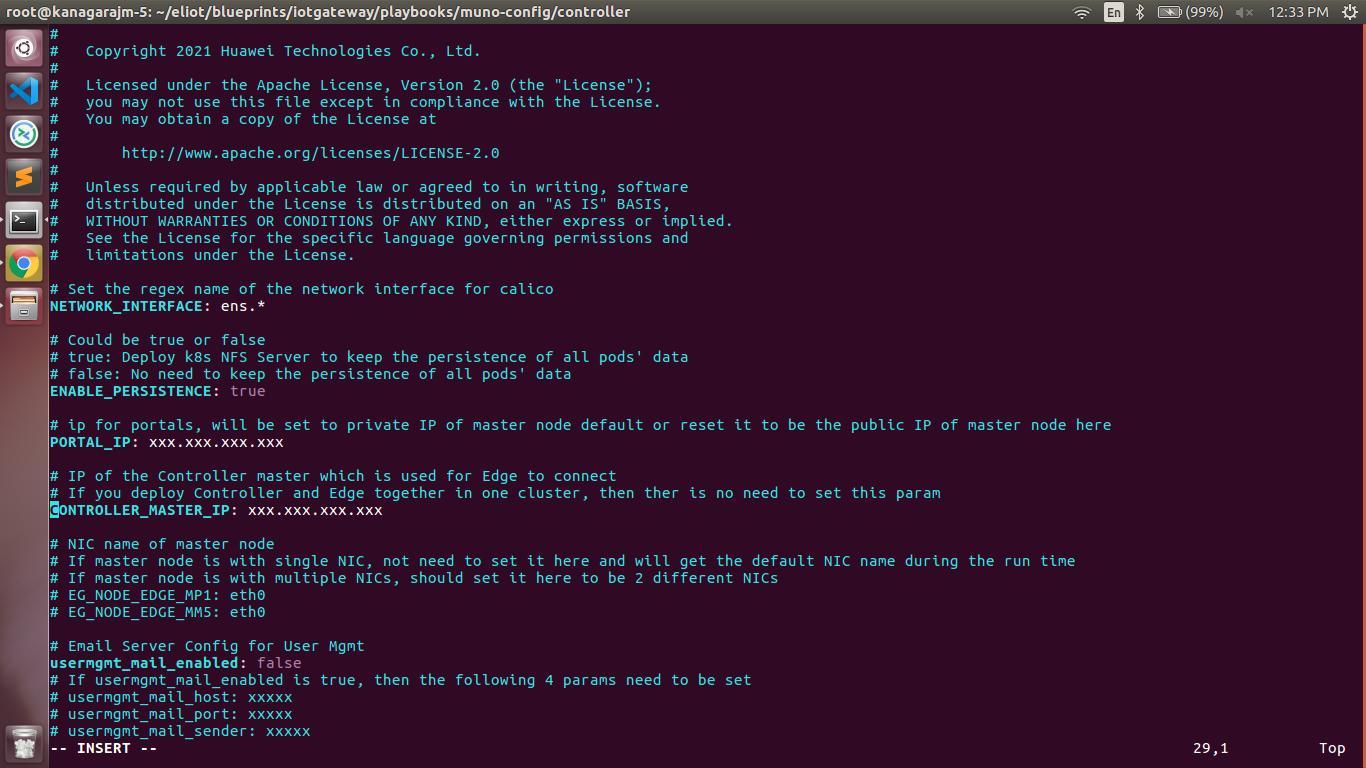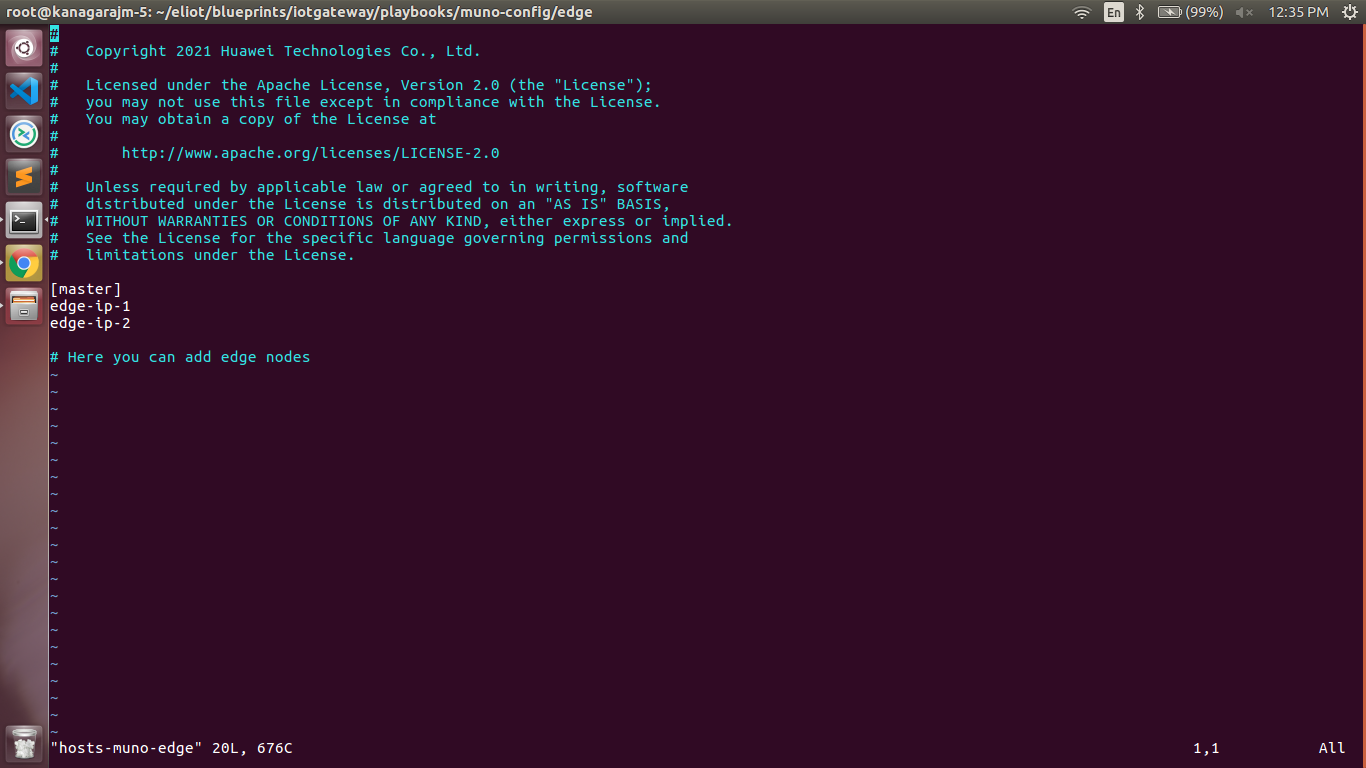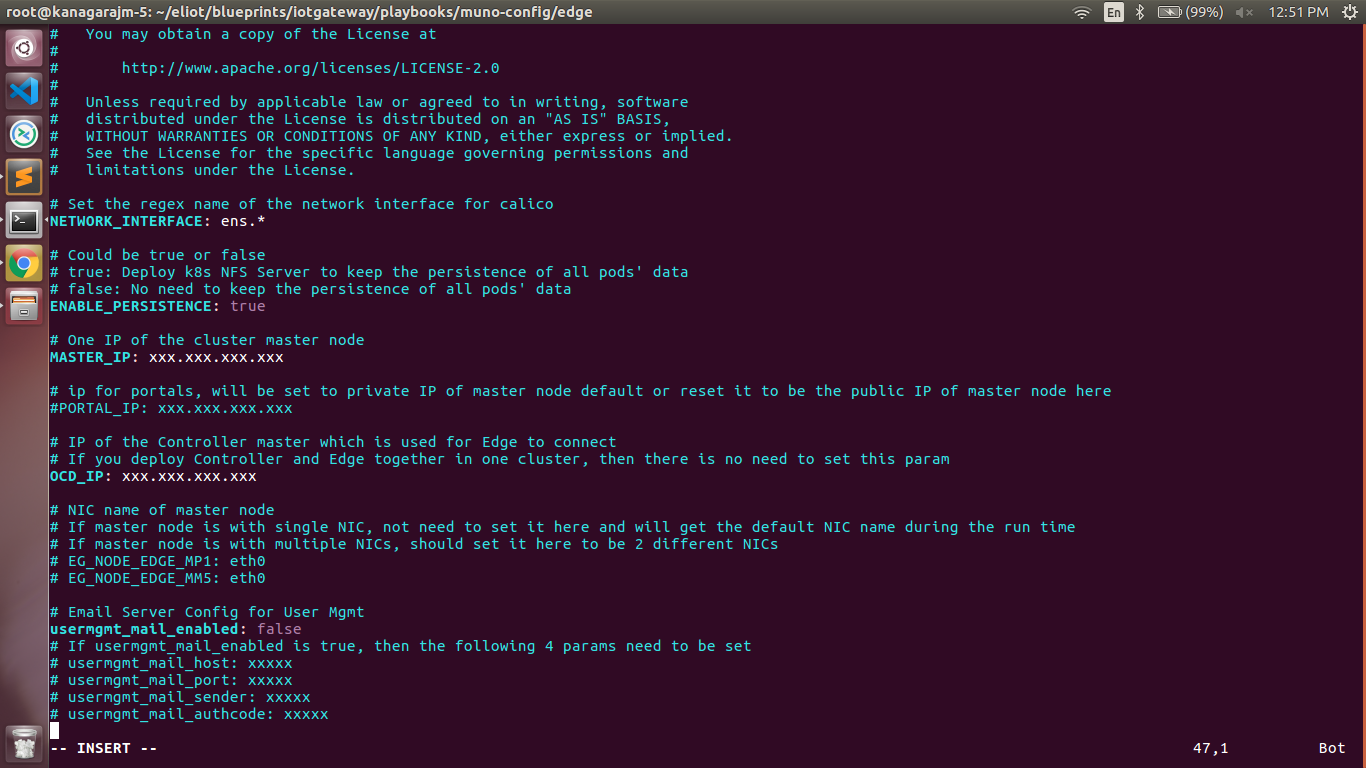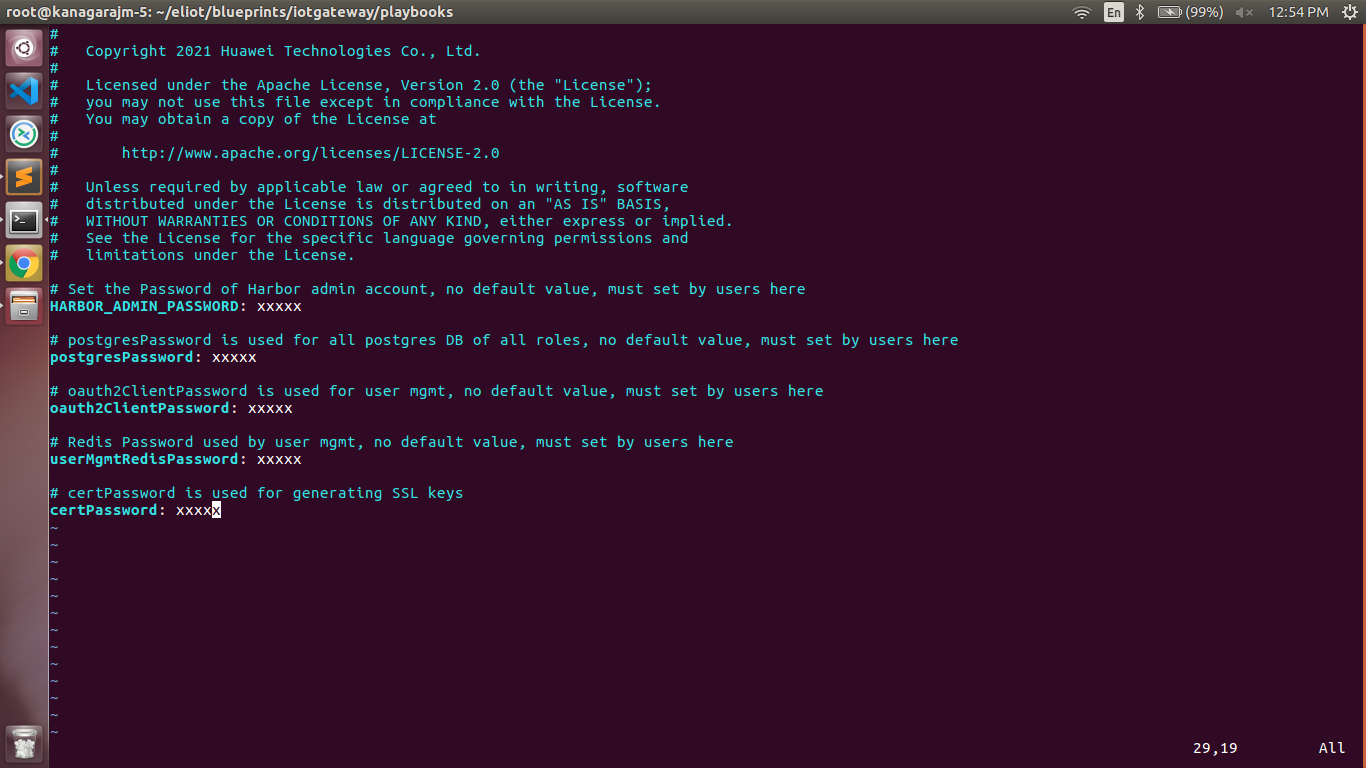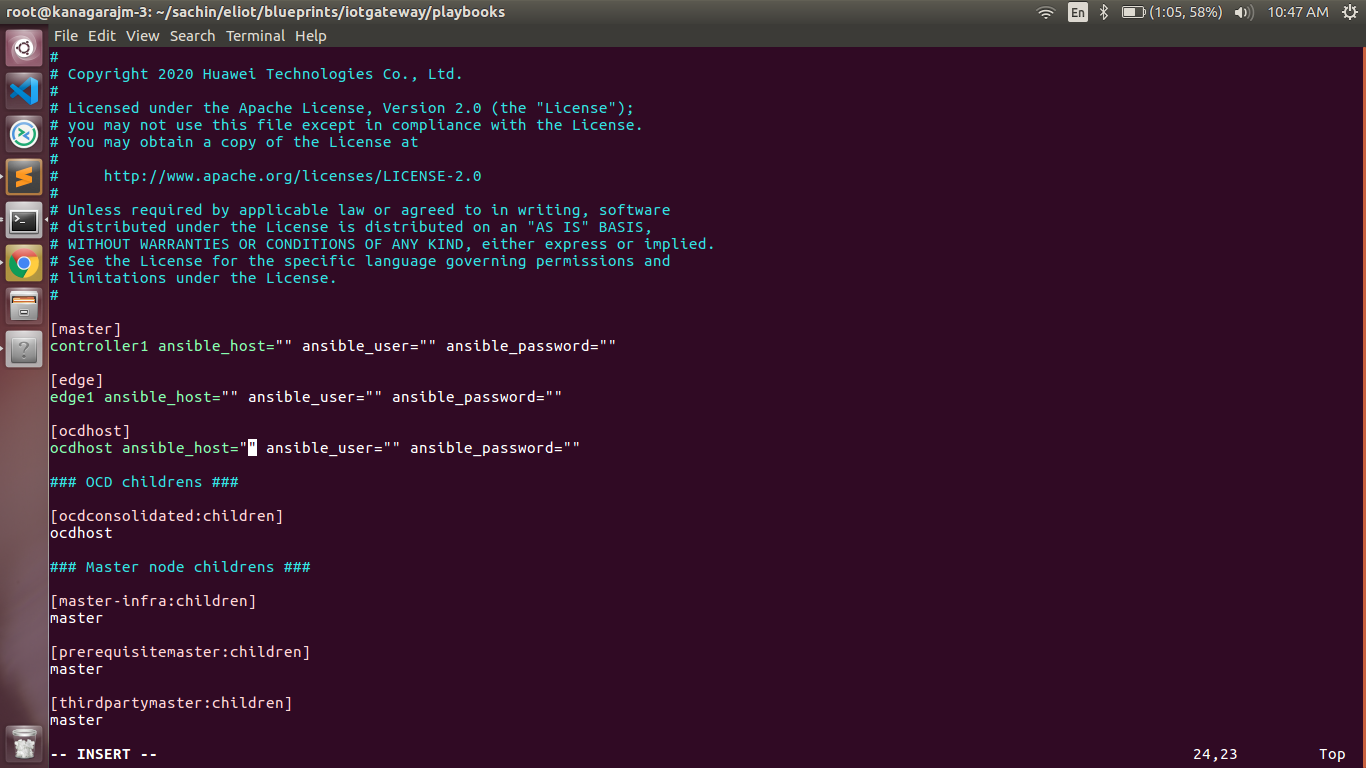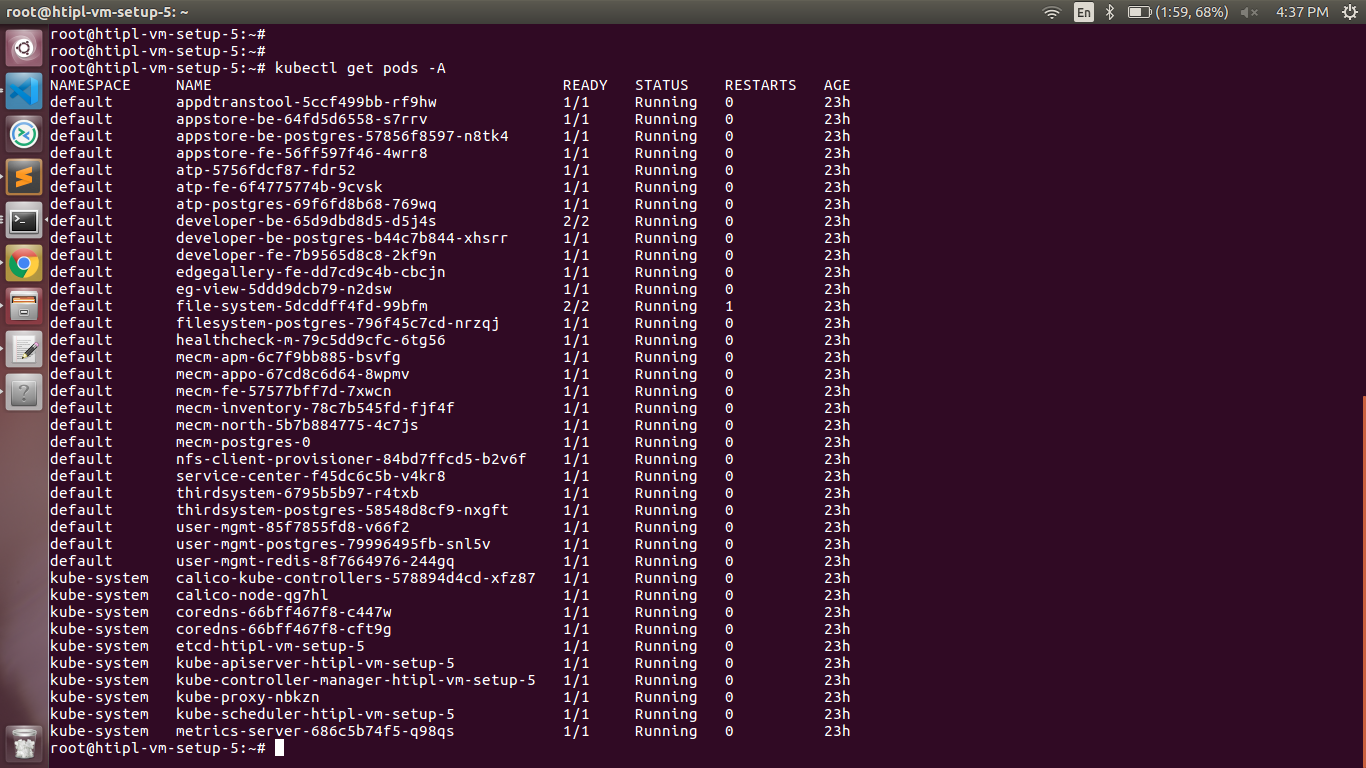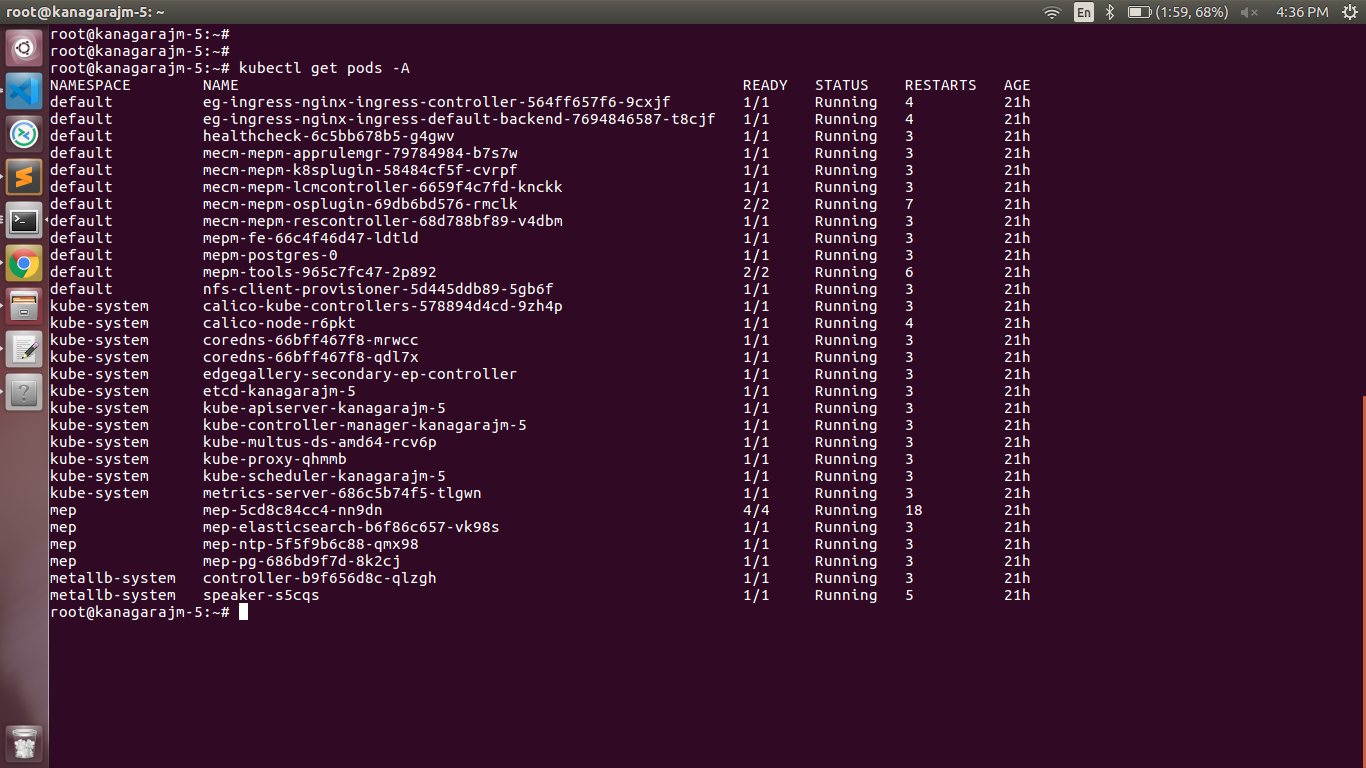...
Note: ELIOT IotGateway Blueprint Deployment has been tested on Cloud VM and is not tested on Bare-Metal Environment. Though, theoretically deployment should work in bare metal, provided hardware and software prerequisites are met. Kindly refer R5 ELIOT R6 - Test Documentation of Edge Lightweight IotGateway (ELIOT)IoT Gateway Test Document to get details on the tested deployment.
...
Minimum Hardware Requirements
ELIOT Master Node | |
|---|---|
| HW Aspect | Requirements |
| # of Node(s) | A virtual machine hosted in any Cloud Provider having internet connectivity. |
| # of CPU | 8 |
| Architecture | x86_AMD64 or ARM64. |
| RAM | 8 GB |
| Disk | 120 GB ~ 512GB |
| Networks | 1 |
IOTGateway Node(s) | |
|---|---|
| HW Aspect | Requirements |
| # of Node(s) | 1 MEC Host |
# of CPU | 4 |
| Architecture | x86_AMD64 or ARM64. |
| RAM | 4 GB |
| Disk | 20 GB ~ 256 GB |
| Network | 1 |
Note: The above specifications are given considering the ELIOT CI / CD environment. User can try lower configuration considering lightweight components being used.
Recommended Hardware Requirements
ELIOT Master Node | |
|---|---|
| HW Aspect | Requirements |
| # of Node(s) | A virtual machine hosted in any Cloud Provider having internet connectivity. |
| # of CPU | 8 |
| Architecture | x86_AMD64 or ARM64. |
| RAM | 8 GB |
| Disk | 120 GB ~ 512GB |
| Networks | 1 |
IOTGateway Node(s) | |
|---|---|
| HW Aspect | Requirements |
| # of Node(s) | 1 MEC Host |
# of CPU | 4 |
| Architecture | x86_AMD64 or ARM64. |
| RAM | 4 GB |
| Disk | 20 GB ~ 256 GB |
| Network | 1 |
Software Prerequisites
- Virtual Machines preinstalled with Ubuntu 18.04 for MECM Node.
- Virtual Machines preinstalled with Ubuntu 18.04 for MEC Host Nodes
- root user created in the Deployment Node, MEC Node and MEC Host Node.
- SSH Server running in all the Nodes.
- Ansible > 2.10.7 installed in One Click Deployment Node (Jump Host)
- git installed in Jump Host.
...
For Virtual Deployment minimum 2 Virtual machines, following are the virtual machines(OCD and Master on same node) and their usage
No | Usage |
|---|---|
| 1 | One Click Deployment Node |
| 2 | ELIOT Master Node |
| 3 | IotGateway Node |
All the nodes should have internet connectivity , network interface and network connectivity between the VM's.
...
Login to the Jump Host and perform the below configuration steps (Steps : as below-
1. Generate public key : #ssh
- ssh-keygen -t rsa
2. Setup password-less login from ocd to center and ocd to edge.
sshpass -p <password> ssh-copy-id -p <ssh-port> -o StrictHostKeyChecking=no root@<node_ip>
3. Review and Change Parameters
For EdgeGallery MUNO Mode
eliot/blueprints/iotgateway/playbooks/muno-config/controller/hosts-muno-controller
eliot/blueprints/iotgateway/playbooks/muno-config/controller/var.yml
eliot/blueprints/iotgateway/playbooks/muno-config/edge/hosts-muno-controller
eliot/blueprints/iotgateway/playbooks/muno-config/edge/var.yml
For EdgeGallery AIO Mode
eliot/blueprints/iotgateway/playbooks/hosts-aio
For ELIOT stack:
eliot/blueprints/iotgateway/playbooks/eliot-inventory.ini
Installing Mode : ELIOT using Ansible-Playbooks
1. git clone the eliot repo, to download the software to install the ELIOT Environment.
root@akraino-mec-0001:~# git clone "https://gerrit.akraino.org/r/eliot"
2. go to the below directory
root@akraino-mec-0001:~# cd eliot/blueprints/iotgateway/playbooks
3. Modify the Configuration File : eliot-inventory.ini with the details of Master and Edge/IotGateway Nodes.
root@akraino-mec-0002:~# vi eliot-inventory.ini
4. Modify other configuration files
Edit the configuration file so that the IP addresses of the OCD, ELIOT Master Node, and IotGateway Node are <ocp_ip>, <master_ip>, and <edge_ip> respectively.
An example of the description of the configuration file when the admin password of HARBOR is <password> is shown below.
$ eliot/blueprints/iotgateway/playbooks/muno-config/controller/hosts-muno-controller
[master]
<master_ip>
-
- If you get authentication issue you can change the permission
# Open file: vi /etc/ssh/sshd_config
- PermitRootLogin yes
- PasswordAuthentication yes
# Restart ssh service:
- sudo systemctl restart ssh.service
For EdgeGallery AIO mode:
Login from ocd to center and ocd to edge in a single node.
- sshpass -p <password> ssh-copy-id -p <ssh-port> -o StrictHostKeyChecking=no root@<node_ip>
For EdgeGallery Muno mode:
Login from ocd to center in a controller node
- sshpass -p <password> ssh-copy-id -p <ssh-port> -o StrictHostKeyChecking=no root@<controller-node_ip>
- sshpass -p <password> ssh-copy-id -p <ssh-port> -o StrictHostKeyChecking=no root@<edge-node_ip>
Login from ocd to edge in a edge node
- sshpass -p <password> ssh-copy-id -p <ssh-port> -o StrictHostKeyChecking=no root@<controller-node_ip>
- sshpass -p <password> ssh-copy-id -p <ssh-port> -o StrictHostKeyChecking=no root@<edge-node_ip>
3. These command are require in both AIO and MUNO(Controller and Edge Node ) mode.
cp -p /etc/passwd /etc/passwd.bkp
cp -p /etc/group /etc/group.bkp
id ubuntu
groupmod -g 600 ubuntu
id ubuntu
4. Review and Change Parameters
For EdgeGallery AIO Mode:
$ eliot/blueprints/iotgateway/playbooks/muno-config/controller/var.ymlHARBOR_ADMIN_PASSWORD: <password>
# Could be true or false
# true: Deploy k8s NFS Server to keep the persistence of all pods' data
# false: No need to keep the persistence of all pods' data
# ENABLE_PERSISTENCE: true
ENABLE_PERSISTENCE: false
# ip for portals, will be set to private IP of master node default or
# reset it to be the public IP of master node here
# PORTAL_IP: xxx.xxx.xxx.xxx
PORTAL_IP: <master_ip>hosts-aio
- Here user can use the private IP af a node
eliot/blueprints/iotgateway/playbooks/var.yml
- NETWORK_INTERFACE: regex for network interface on the VM. (user can be check ineterrface name by ifconfig and provide inerface name accordingly for example like eth.* )
- MASTER_IP: Here user can use the private IP of a node
- PORTAL_IP: If portal need to be access over internet then uncomment the PORTAL_IP and use public IP as a PORTAL_IP otherwise portal will be accessible only on private IP default.
eliot$ eliot/blueprints/iotgateway/playbooks/muno-config/edge/hosts-muno-edge
[master]
<edge_ip>$ eliot/blueprints/iotgateway/playbooks/muno-config/edge/var.ymlHARBOR_ADMIN_PASSWORD: <password>
# Could be true or false
# true: Deploy k8s NFS Server to keep the persistence of all pods' data
# false: No need to keep the persistence of all pods' data
ENABLE_PERSISTENCE: false
# ip for portals, will be set to private IP of master node default or
# reset it to be the public IP of master node here
# PORTAL_IP: xxx.xxx.xxx.xxx
# NIC name of master node
# If master node is with single NIC, not need to set it here and will get
# the default NIC name during the run time
# If master node is with multiple NICs, should set it here to be
# 2 different NICs
# EG_NODE_EDGE_MP1: eth0
# EG_NODE_EDGE_MM5: eth0
OCD_IP: <ocp_ip>
5.Send the git clone file from OCD to ELIOT Master Node and IotGateway Node.
$ scp -r ./eliot <node_ip>:~
For Edge Gallery installation:
Select one of Multi Node Inventory Mode (MUNO-Mode) or All in one mode (AIO mode) and install it.
MUNO-Mode:
Execute the below command:
cd eliot/blueprints/iotgateway/playbooks
ansible-playbook -i muno-config/controller/hosts-muno-controller eliot-eg-muno-controller.yml --extra-vars "operation=install" -e "ansible_user=root"
ansible-playbook -i muno-config/edge/hosts-muno-edge eliot-eg-muno-edge.yml --extra-vars "operation=install" -e "ansible_user=root"
For AIO mode:
Execute the below command
cd ealt-edge/ocd/infra/playbooks
root@akraino-mec-0001:~#ansible-playbook eliot-eg-aio-latest.yml -i hosts-aio --extra-vars "operation=install" -e ansible_user=root"
FOR ELIOT Stack:
Execute the below command
Setup environment -
root@akraino-mec-0001:~# ansible-playbook eliot-all.yml -i eliot-inventory.ini --extra-vars "operation=install"
Once the execution is completed in console will see prompt "ELIOTEdge Environment Installed , Components Install ELIOT Master and EDGE Nodes Successfully"
Snapshot Deployment Overview
N/A
Special Requirements for Virtual Deployments
N/A
Install Jump Host
N/A
Verifying the Setup - VM's
N/A
Upstream Deployment Guide
Upstream Deployment Key Features
N/A
Special Requirements for Upstream Deployments
N/A
Scenarios and Deploy Settings for Upstream Deployments
N/A
Including Upstream Patches with Deployment
N/A
Running
N/A
Interacting with Containerized Overcloud
N/A
Verifying the Setup
Verifying ELIOT IotGateway Deployment
Currently the verification is manually done.
- Login to the Master Node and check whether K8S cluster is installed.
- Check the below mentioned components and services are running as Pods / Services in Kubernetes cluster
- Edge Gallery
- grafana
- rabbitmq
- cadvisor
- edgex
- Hawkbit
- opc-ua
- Login to Edge Host and verify the worker node setup
Components and Services running in ELIOT Master Node
Components and Services running ELIOT IotGateway/ Edge Node
Deploy Application in ELIOT
- Login to MECM Portal https://ip:30093
1.1 click on Systems ->App LCM ->New Registration
Name: Applcm(any general name)
IP: applcm"public ip"
Port: 30204
1.2. Click on Systems ->App Rule -> New Registration
Name: Apprule(any general name)
IP: applcm"public ip"
Port: 30206
1.3. click on Systems ->App Store ->New Registration
App Store Name: appstore(any general name)
IP: Appstore public ip
Port: 30099
Appstore Repo: {HarborIP:443}(192.168.1.1:443)
Repo Name: appstore(any general name)
Repo Username: admin(harbor user name)
Repo Password: Harbor12345(harbor password)
Vendor: vendor(any general name)
2. Login to Developer Portal https://ip:30092
2.1. Add sandbox env to deploy application before publish
Click System ->Host Management ->Add Host
Name: general name
System: k8s
Lcmip: sandbox ip(for testing purpose can provide edge ip, if no sandbox env)
mecHost: sandbox ip(for testing purpose can provide edge ip, if no sandbox env)
Port: 31252
Protocol: https
Architecture: X86
Status: Normal
Port Range: leave as it is
Address: Bangalore
UploadConfig File: upload sandboxenvkubeconfig file
2.2 Click on Workspace -> Create Project -> Application Integration -> Start
- Provide App Name, Version, Provider, Workload Type, Architecture, Industry, Type.
- Upload Icon, provide Description. And click on confirm.
2.3. Now click on Deployment Test.
- Upload Docker images directly from portal by clicking on Upload App Image
Or, directly push Docker images to Harbor repo (takes lesser time, preferred)
- Click next, upload deployment yaml file now.
- After config upload, click next and click start deployment
- After Deployment is success, click on Release Recourses
Note:
- While Deployment test if any error happens, open ATP portal (https://ip:30094) in another tab of browser, sing in, come back to developer portal and re run deployment test
- gitee.com/edgegallery/applications repo provides, A lot of applications with their logo, deployment yaml & user guides
2.4. Now click on Application Release
Upload file for Application Description
password-var.yml
- All passwords must include capital letters, lowercase letters, numbers and special characters and whose length must be no less than 8 characters. Also there should be no special characters
&in it. Otherwise, the deployment will failed because of these simple passwords. - A sample password could be "Harbor@12345"
For EdgeGallery MUNO Mode:
eliot/blueprints/iotgateway/playbooks/muno-config/controller/hosts-muno-controller
- Here user can use the private IP as a master IP of a Controller node
eliot/blueprints/iotgateway/playbooks/muno-config/controller/var.yml
- NETWORK_INTERFACE: regex for network interface on the VM. (user can be check ineterrface name by ifconfig and provide inerface name accordingly for example like eth.* )
- MASTER_IP: Here user can use the private IP 0f a controller node
- PORTAL_IP: If portal need to be access over internet then uncomment the PORTAL_IP and use public IP as a PORTAL_IP otherwise portal will be accessible only on private IP default.
CONTROLLER_MASTER_IP: Uncomment the PORTAL_IP and use private IP of a the Controller node
eliot/blueprints/iotgateway/playbooks/muno-config/edge/hosts-muno-edge
- Here user can use the private IP as a master IP of a Edge node
eliot/blueprints/iotgateway/playbooks/muno-config/edge/var.yml
- NETWORK_INTERFACE: regex for network interface on the VM. (user can be check ineterrface name by ifconfig and provide inerface name accordingly for example like eth.* )
- MASTER_IP: Here user can use the private IP of a edge node
- OCD_IP: Here user can use the private IP of a Controller Node which is used for Edge to connect
eliot/blueprints/iotgateway/playbooks/password-var.yml
- All passwords must include capital letters, lowercase letters, numbers and special characters and whose length must be no less than 8 characters. Also there should be no special characters
&in it. Otherwise, the deployment will failed because of these simple passwords. - A sample password could be "Harbor@12345"
For ELIOT stack:
eliot/blueprints/iotgateway/playbooks/eliot-inventory.ini
- Here user can put the public IP in center, edge, ocdhost node.
Installing Mode : ELIOT using Ansible-Playbooks
1. git clone the eliot repo, to download the software to install the ELIOT Environment.
root@akraino-mec-0001:~# git clone "https://gerrit.akraino.org/r/eliot"
2. go to the below directory
root@akraino-mec-0001:~# cd eliot/blueprints/iotgateway/playbooks
3. Modify the Configuration File : eliot-inventory.ini with the details of Master and Edge/IotGateway Nodes.
root@akraino-mec-0002:~# vi eliot-inventory.ini
For Edge Gallery installation:
- Select one of Multi Node Inventory Mode (MUNO-Mode) or All in one mode (AIO mode) and install it.
MUNO-Mode:
Execute the below command:
cd eliot/blueprints/iotgateway/playbooks
ansible-playbook -i muno-config/controller/hosts-muno-controller eliot-eg-muno-controller.yml --extra-vars "operation=install" -e "ansible_user=root"
ansible-playbook -i muno-config/edge/hosts-muno-edge eliot-eg-muno-edge.yml --extra-vars "operation=install" -e "ansible_user=root"
For AIO mode:
Execute the below command
cd ealt-edge/ocd/infra/playbooks
ansible-playbook eliot-eg-aio-latest.yml -i hosts-aio --extra-vars "operation=install" -e "ansible_user=root"
FOR ELIOT Stack:
Execute the below command
Setup environment -
ansible-playbook eliot-all.yml -i eliot-inventory.ini --extra-vars "operation=install"
Once the execution is completed in console will see prompt "ELIOTEdge Environment Installed , Components Install ELIOT Master and EDGE Nodes Successfully"
Snapshot Deployment Overview
N/A
Special Requirements for Virtual Deployments
N/A
Install Jump Host
N/A
Verifying the Setup - VM's
N/A
Upstream Deployment Guide
Upstream Deployment Key Features
N/A
Special Requirements for Upstream Deployments
N/A
Scenarios and Deploy Settings for Upstream Deployments
N/A
Including Upstream Patches with Deployment
N/A
Running
N/A
Interacting with Containerized Overcloud
N/A
Verifying the Setup
Verifying ELIOT IotGateway Deployment
Currently the verification is manually done.
- Login to the Master Node and check whether K8S cluster is installed.
- Check the below mentioned components and services are running as Pods / Services in Kubernetes cluster
- Edge Gallery
- grafana
- rabbitmq
- cadvisor
- edgex
- Hawkbit
- opc-ua
- Login to Edge Host and verify the worker node setup
For muno mode
Components and Services running in ELIOT Controller node
Components and Services running ELIOT Edge Node
Deploy Application in ELIOT
- Login to MECM Portal https://ip:30093
1.1 click on Systems ->App LCM ->New Registration
Name: Applcm(any general name)
IP: applcm"public ip"
Port: 30204
1.2. click on Systems ->App Store ->New Registration
App Store Name: appstore(any general name)
IP: Appstore public ip
Port: 30099
Appstore Repo: {HarborIP:443}(192.168.1.1:443)
Repo Name: appstore(any general name)
Repo Username: admin(harbor user name)
Repo Password: Harbor12345(harbor password)
Vendor: vendor(any general name)
2. Login to Developer Portal https://ip:30092
2.1. Add sandbox env to deploy application before publish
Click System ->Host Management ->Add Host
Name: general name
System: k8s
Lcmip: sandbox ip(for testing purpose can provide edge ip, if no sandbox env)
mecHost: sandbox ip(for testing purpose can provide edge ip, if no sandbox env)
Port: 31252
Protocol: https
Architecture: X86
Status: Normal
Port Range: leave as it is
Address: Bangalore
UploadConfig File: upload sandboxenvkubeconfig file Click save config, click Next Step, click Start Test, scroll down to find & click Start Test button, click Next Step, click publish to publish application to appstore.
3. Login to MECM Portal https://ip:30093
3.1. Add k8s node::
Click on Edge Nodes ->New Rgistration
VM: k8s
Name: edge1
IP: edge public ip
Click on Edge Nodes ->New Rgistration Location: select from drop down
VM Address: k8syanta
Name: edge1 Coordinates: 116.39,39.90
IP Architecture: edge public ipx86
Location Capabilities: select from drop downnone
Address: yanta MEPM: select applcm node from dropdown
3.2. Download /root/.kube/config file from edge node
Coordinates: 116.39,39.90 Architecture: x86 And click on Upload config file to upload.
4. Demonstration of application Development & Deployment
Capabilities: select none4.1 Application Development
MEPM: select applcm node from dropdownlink - https://www.youtube.com/watch?v=AjQNG5d3p84&t=23s
3.2. Download /root/.kube/config file from edge node 4.2 Application Deployment
And click on Upload config file to upload.link - https://www.youtube.com/watch?v=PbxKpslVnmc&t=31s
Developer Guide and Troubleshooting
...
License information of ELIOT Blueprint Components
ELIOT Master Node
| S. No | Software | Type | Version | License | Remarks |
| 1. | Docker | CRI | 18.09 | Apache 2.0 license | No code modifications done |
| 2. | Kubernetes | Orchestration | v1.18.7 | Apache 2.0 license | No code modifications done |
| 3. | Edge Gallery | Open Source MEC Platform | 1.1.1 | Apache 2.0 license | Open Source MEC Platform |
| 4. | Grafana | Monitoring | 7.1.1 | Apache 2.0 license |
EDGE / IotGateway Node
| S. No | Software | Type | Version | License Information | Remarks |
| 1. | Docker | CRI | 18.09 | Apache 2.0 license | No code modifications done |
| 2. | K8s | Orchestration | 1.18.7 | Apache 2.0 license | No code modifications done |
| 3. | Edge Gallery | Open Source MEC Platform | 1.1.1 | Apache 2.0 license | No code modifications done |
| 4. | cAdvisor | Container Metrics | v0.36.0 | Apache 2.0 license | No code modifications done |
| 5. | RabbitMQ | Message Broker | 3.7 | Mozilla Public License | No code modifications done. RabbitMQ image is deployed as is. |
| 6. | Prometheus | Metrics Collector | 9.3.1 | Apache 2.0 license | Code part of Edge Gallery |
| 7. | OPC-UA | IoT Protocol | Geneva | Apache 2.0 license | Upstream |
| 11 | EdgeX | Services | Edinburgh | Apache 2.0 license | Upstream |
References
Definitions, acronyms and abbreviations
...
